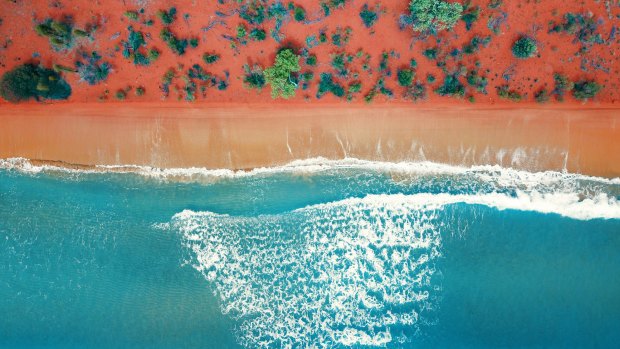This was published 3 years ago
The Kimberley, Western Australia is one of the world's most remote wildernesses

Dramatic rusty red cliffs, deep sandstone gorges, vast open vistas and some 12,000 kilometres of spectacular coastline form the backdrop for the world’s oldest continuous culture. Credit: Getty Images
If your travel ideals have changed during isolation and crowded places now fill you with horror, an expedition cruise in the Kimberley on a small ship with a few like-minded souls might be just the thing to ease you back into the big wide world.
The Kimberley is certainly big – twice the size of Victoria and three times as big as England – and it's one of the world's most remote wilderness areas. Dramatic rusty red cliffs, deep sandstone gorges, vast open vistas and some 12,000 kilometres of spectacular coastline form the backdrop for the world's oldest continuous culture.
The land itself is ancient – much of it is at least 1.8 billion years old – and has been inhabited by Indigenous people for at least 40,000 years and possibly 65,000. An expedition cruise will take you to caves where you'll see rock art dating back centuries, along with extraordinary natural phenomena caused by giant tides, extravagant sunrises and sunsets, and a plethora of birdlife.
Cruises generally run between Broome and Darwin over 10 or 11 days during the April-September dry season. So when is the best time to go? We asked Mick Fogg, award-winning photographer and expedition manager for French luxury expedition line Ponant, who has spent more time than most exploring this rugged region.
"If I had to pick the 'best' time of the year on the Kimberley coast, it would be mid- to late July," he says. "Most years, there's still some water in the twin falls of King George and the receding freshwater concentrates the wildlife, making encounters a little easier.
"It is also at this time that the largest migration of humpback whales in the world makes its way along the Kimberley coast. From mid-July, these majestic leviathans are regularly seen from guest balconies and open decks, with close encounters by our fleet of Zodiacs a highlight for the lucky few."
Montgomery Reef is a highlight at any time during the season, but if you are there when a king tide is running, it is even more astonishing. Zodiacs take you to the huge reef site when it is covered by water and, as the tide drops, the reef appears to rise before your eyes. Cascading waterfalls reveal jumping fish, green turtles swimming in the swirling sea and birds swooping down to pick out marine delicacies – a mesmerising spectacle.
While bird lovers are in heaven in this part of the world – the Lacepedes Islands alone are home to colonies of brown and masked boobies, roseate terns, pelicans, frigatebirds and pied and sooty oystercatchers – art lovers, photographers and historians are equally entranced by the Kimberley's outdoor rock art galleries.
As Mick Fogg explains, "Each site we visit on our coastal voyages has its own attraction and showcases the Gwion Gwion and Wandjina styles that are unique to the Kimberley region. The art sites at Warrabii, or Swift Bay, are among my favourites, [as they have] great examples of both rock art styles."
At Vansittart Bay, another site for Aboriginal art, there's evidence of more recent history. During World War II, a DC3 plane crash-landed on the saltpan en route from Perth to Darwin, and although the four crew and two passengers were rescued, the plane's skeleton remains more or less intact. You can scramble through its innards and take selfies in the cockpit.
Photo ops abound on the Zodiac ride along the King George River to the twin falls. For a croc-free dip, it's worth making the steep trek to the natural rockpool at the top of the cascades. Or choose a ship with a pool on board.
What to Watch: Baz Luhrmann's epic 2008 movie Australia might be completely over the top, but whatever your opinion about the storyline, the photogenic locations are inspirational. Look out for scenes shot at King George Falls, while the Bungle Bungles – those distinctive striped "beehive" domes in Purnululu National Park that provide spectacular viewing if you get the chance to take a scenic flight – also feature in the film.
This article appears in Sunday Life magazine within the Sun-Herald and the Sunday Age on sale July 12.
Sign up for the Traveller Deals newsletter
Get exclusive travel deals delivered straight to your inbox. Sign up now.